Business Operations Report: How Businesses Operate in the UK
VerifiedAdded on 2020/12/09
|17
|4624
|201
Report
AI Summary
This report provides a detailed analysis of business operations within the UK, covering various aspects from organizational structures to the impact of the economic environment. It begins by differentiating between public and private sector organizations like Tesco and Greenergy, and explores the different structures within UK businesses, including sole proprietorships, limited partnerships, and non-profit corporations. The report examines the impact of local, national, and global economic factors on retail businesses, using Asda as a case study. It emphasizes the importance of accounting for business success and defines the functions of the HR department, including recruitment, job safety, employee relations, and training. Additionally, the report interprets information from profit and loss accounts and outlines the role of leadership and team members, discussing team development stages, motivational theories, and leadership styles. Finally, it explores the impact of customer service and customer profiling on business success.
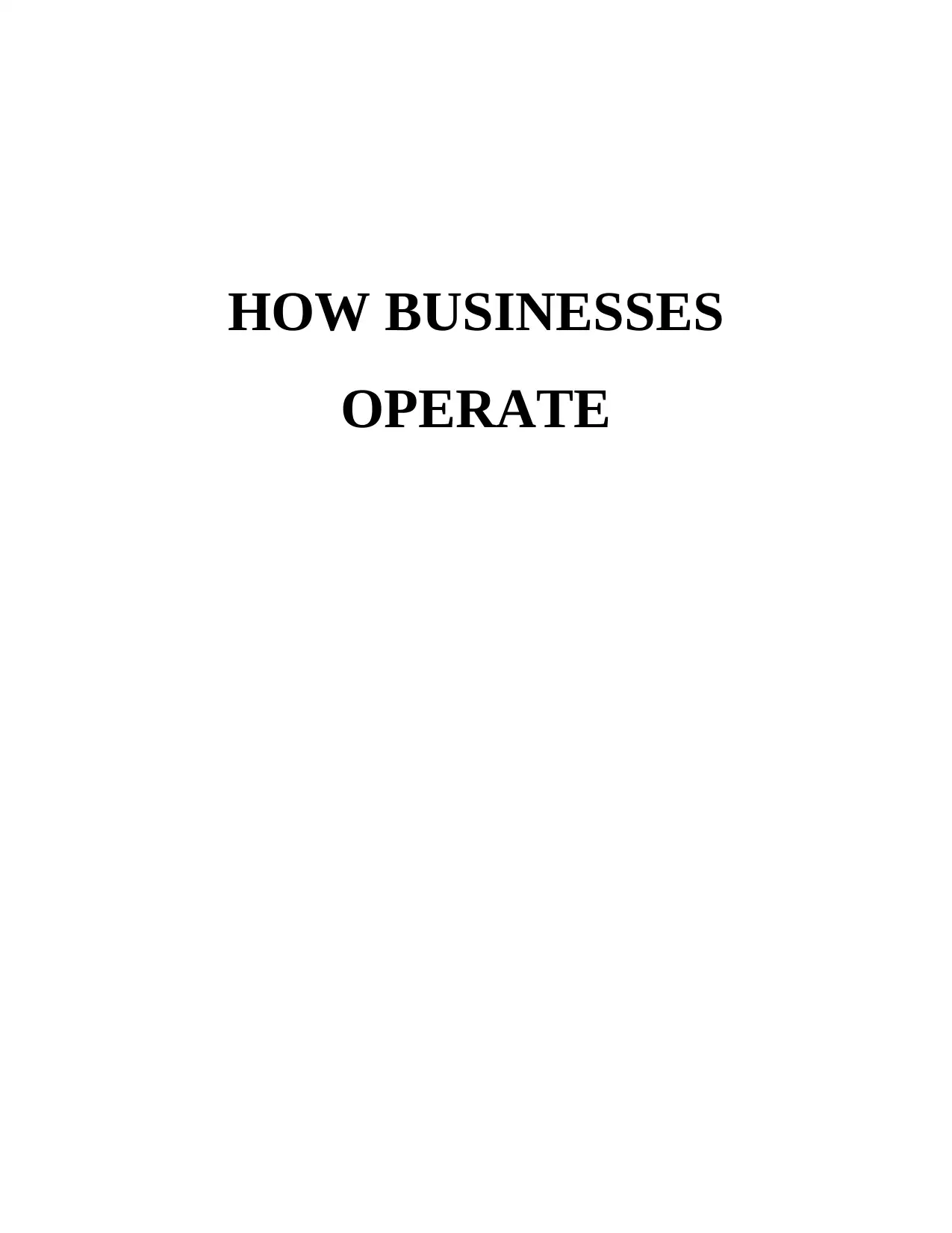
HOW BUSINESSES
OPERATE
OPERATE
Paraphrase This Document
Need a fresh take? Get an instant paraphrase of this document with our AI Paraphraser
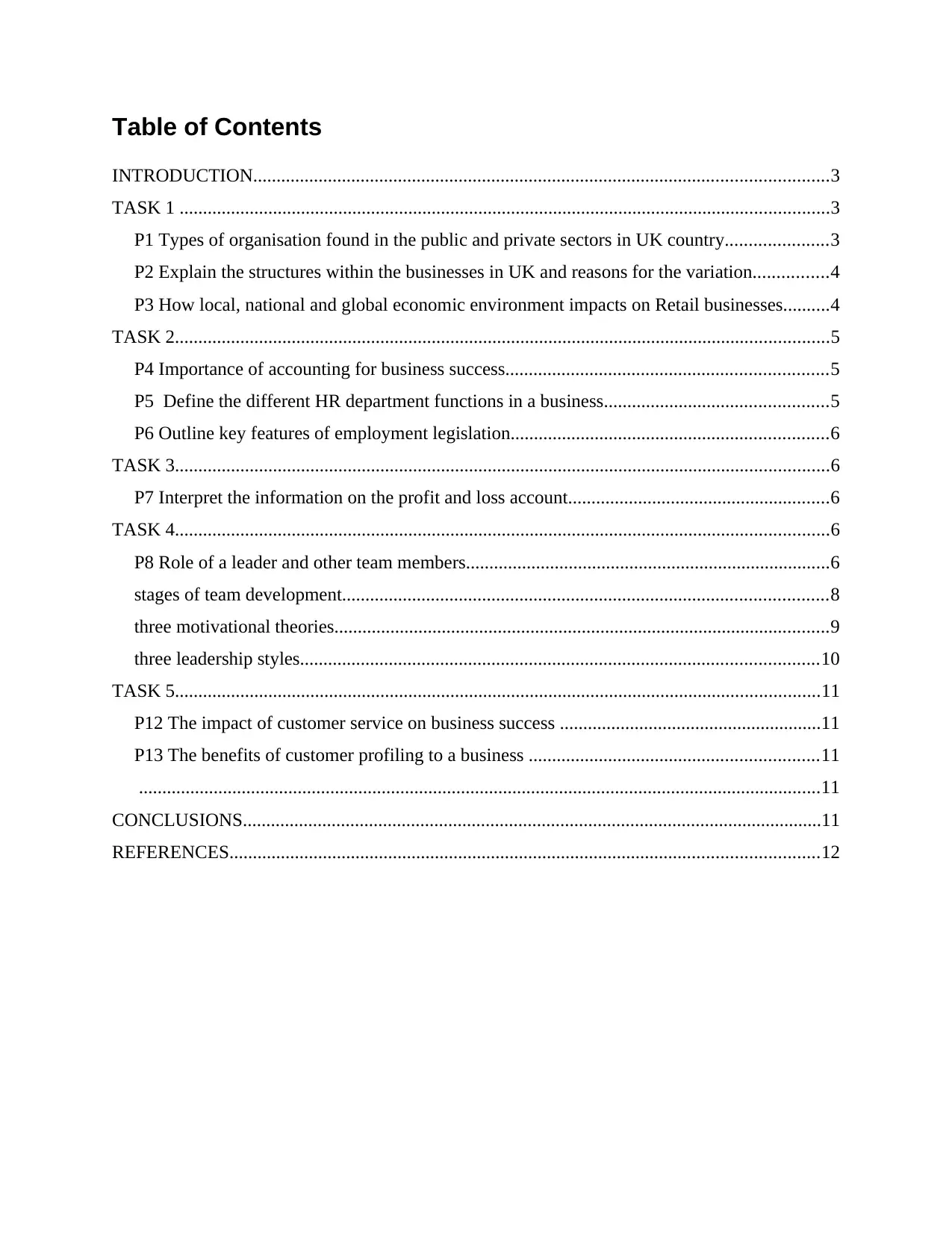
Table of Contents
INTRODUCTION...........................................................................................................................3
TASK 1 ...........................................................................................................................................3
P1 Types of organisation found in the public and private sectors in UK country......................3
P2 Explain the structures within the businesses in UK and reasons for the variation................4
P3 How local, national and global economic environment impacts on Retail businesses..........4
TASK 2............................................................................................................................................5
P4 Importance of accounting for business success.....................................................................5
P5 Define the different HR department functions in a business................................................5
P6 Outline key features of employment legislation....................................................................6
TASK 3............................................................................................................................................6
P7 Interpret the information on the profit and loss account........................................................6
TASK 4............................................................................................................................................6
P8 Role of a leader and other team members..............................................................................6
stages of team development........................................................................................................8
three motivational theories..........................................................................................................9
three leadership styles...............................................................................................................10
TASK 5..........................................................................................................................................11
P12 The impact of customer service on business success ........................................................11
P13 The benefits of customer profiling to a business ..............................................................11
..................................................................................................................................................11
CONCLUSIONS............................................................................................................................11
REFERENCES..............................................................................................................................12
INTRODUCTION...........................................................................................................................3
TASK 1 ...........................................................................................................................................3
P1 Types of organisation found in the public and private sectors in UK country......................3
P2 Explain the structures within the businesses in UK and reasons for the variation................4
P3 How local, national and global economic environment impacts on Retail businesses..........4
TASK 2............................................................................................................................................5
P4 Importance of accounting for business success.....................................................................5
P5 Define the different HR department functions in a business................................................5
P6 Outline key features of employment legislation....................................................................6
TASK 3............................................................................................................................................6
P7 Interpret the information on the profit and loss account........................................................6
TASK 4............................................................................................................................................6
P8 Role of a leader and other team members..............................................................................6
stages of team development........................................................................................................8
three motivational theories..........................................................................................................9
three leadership styles...............................................................................................................10
TASK 5..........................................................................................................................................11
P12 The impact of customer service on business success ........................................................11
P13 The benefits of customer profiling to a business ..............................................................11
..................................................................................................................................................11
CONCLUSIONS............................................................................................................................11
REFERENCES..............................................................................................................................12
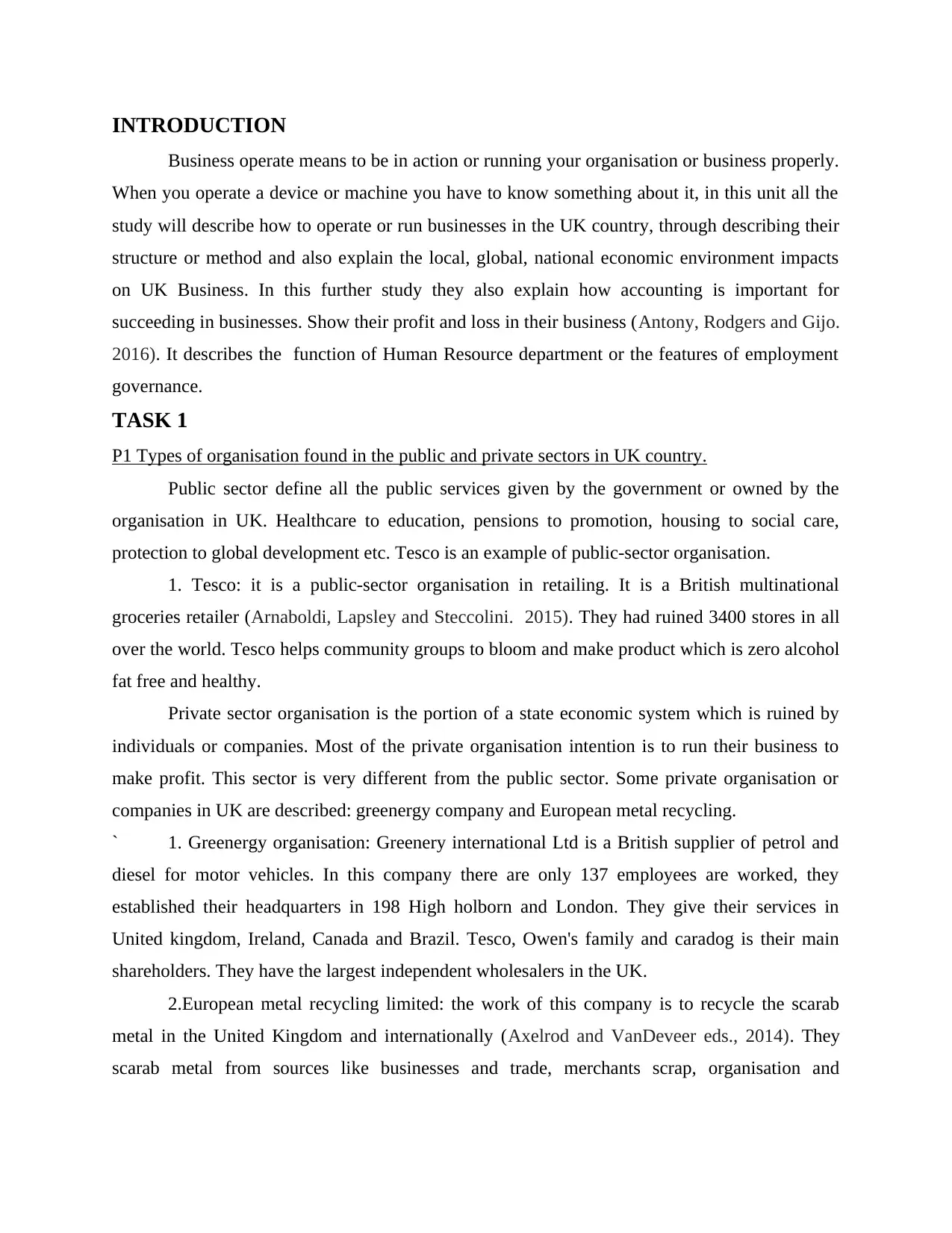
INTRODUCTION
Business operate means to be in action or running your organisation or business properly.
When you operate a device or machine you have to know something about it, in this unit all the
study will describe how to operate or run businesses in the UK country, through describing their
structure or method and also explain the local, global, national economic environment impacts
on UK Business. In this further study they also explain how accounting is important for
succeeding in businesses. Show their profit and loss in their business (Antony, Rodgers and Gijo.
2016). It describes the function of Human Resource department or the features of employment
governance.
TASK 1
P1 Types of organisation found in the public and private sectors in UK country.
Public sector define all the public services given by the government or owned by the
organisation in UK. Healthcare to education, pensions to promotion, housing to social care,
protection to global development etc. Tesco is an example of public-sector organisation.
1. Tesco: it is a public-sector organisation in retailing. It is a British multinational
groceries retailer (Arnaboldi, Lapsley and Steccolini. 2015). They had ruined 3400 stores in all
over the world. Tesco helps community groups to bloom and make product which is zero alcohol
fat free and healthy.
Private sector organisation is the portion of a state economic system which is ruined by
individuals or companies. Most of the private organisation intention is to run their business to
make profit. This sector is very different from the public sector. Some private organisation or
companies in UK are described: greenergy company and European metal recycling.
` 1. Greenergy organisation: Greenery international Ltd is a British supplier of petrol and
diesel for motor vehicles. In this company there are only 137 employees are worked, they
established their headquarters in 198 High holborn and London. They give their services in
United kingdom, Ireland, Canada and Brazil. Tesco, Owen's family and caradog is their main
shareholders. They have the largest independent wholesalers in the UK.
2.European metal recycling limited: the work of this company is to recycle the scarab
metal in the United Kingdom and internationally (Axelrod and VanDeveer eds., 2014). They
scarab metal from sources like businesses and trade, merchants scrap, organisation and
Business operate means to be in action or running your organisation or business properly.
When you operate a device or machine you have to know something about it, in this unit all the
study will describe how to operate or run businesses in the UK country, through describing their
structure or method and also explain the local, global, national economic environment impacts
on UK Business. In this further study they also explain how accounting is important for
succeeding in businesses. Show their profit and loss in their business (Antony, Rodgers and Gijo.
2016). It describes the function of Human Resource department or the features of employment
governance.
TASK 1
P1 Types of organisation found in the public and private sectors in UK country.
Public sector define all the public services given by the government or owned by the
organisation in UK. Healthcare to education, pensions to promotion, housing to social care,
protection to global development etc. Tesco is an example of public-sector organisation.
1. Tesco: it is a public-sector organisation in retailing. It is a British multinational
groceries retailer (Arnaboldi, Lapsley and Steccolini. 2015). They had ruined 3400 stores in all
over the world. Tesco helps community groups to bloom and make product which is zero alcohol
fat free and healthy.
Private sector organisation is the portion of a state economic system which is ruined by
individuals or companies. Most of the private organisation intention is to run their business to
make profit. This sector is very different from the public sector. Some private organisation or
companies in UK are described: greenergy company and European metal recycling.
` 1. Greenergy organisation: Greenery international Ltd is a British supplier of petrol and
diesel for motor vehicles. In this company there are only 137 employees are worked, they
established their headquarters in 198 High holborn and London. They give their services in
United kingdom, Ireland, Canada and Brazil. Tesco, Owen's family and caradog is their main
shareholders. They have the largest independent wholesalers in the UK.
2.European metal recycling limited: the work of this company is to recycle the scarab
metal in the United Kingdom and internationally (Axelrod and VanDeveer eds., 2014). They
scarab metal from sources like businesses and trade, merchants scrap, organisation and
⊘ This is a preview!⊘
Do you want full access?
Subscribe today to unlock all pages.

Trusted by 1+ million students worldwide
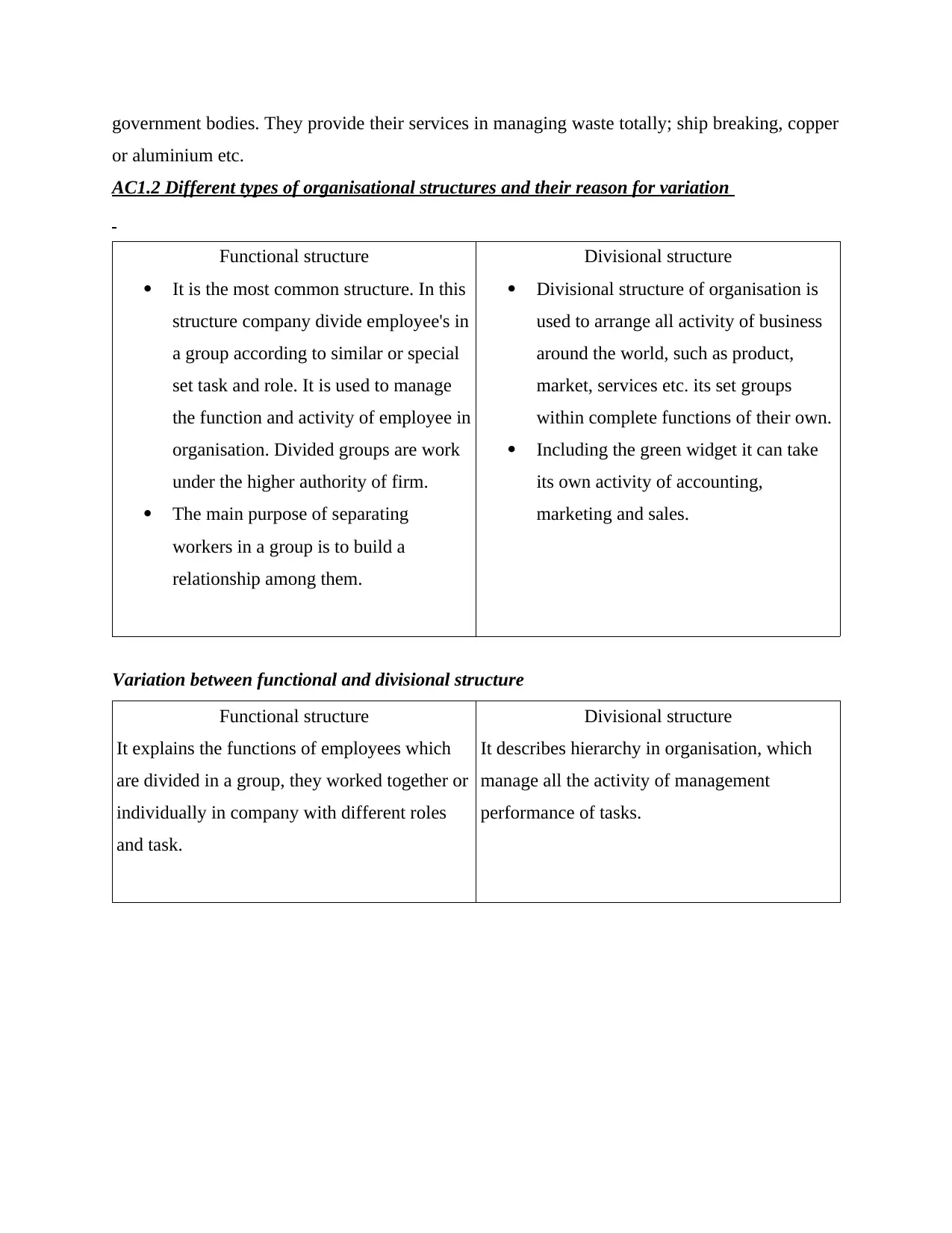
government bodies. They provide their services in managing waste totally; ship breaking, copper
or aluminium etc.
AC1.2 Different types of organisational structures and their reason for variation
Functional structure
It is the most common structure. In this
structure company divide employee's in
a group according to similar or special
set task and role. It is used to manage
the function and activity of employee in
organisation. Divided groups are work
under the higher authority of firm.
The main purpose of separating
workers in a group is to build a
relationship among them.
Divisional structure
Divisional structure of organisation is
used to arrange all activity of business
around the world, such as product,
market, services etc. its set groups
within complete functions of their own.
Including the green widget it can take
its own activity of accounting,
marketing and sales.
Variation between functional and divisional structure
Functional structure
It explains the functions of employees which
are divided in a group, they worked together or
individually in company with different roles
and task.
Divisional structure
It describes hierarchy in organisation, which
manage all the activity of management
performance of tasks.
or aluminium etc.
AC1.2 Different types of organisational structures and their reason for variation
Functional structure
It is the most common structure. In this
structure company divide employee's in
a group according to similar or special
set task and role. It is used to manage
the function and activity of employee in
organisation. Divided groups are work
under the higher authority of firm.
The main purpose of separating
workers in a group is to build a
relationship among them.
Divisional structure
Divisional structure of organisation is
used to arrange all activity of business
around the world, such as product,
market, services etc. its set groups
within complete functions of their own.
Including the green widget it can take
its own activity of accounting,
marketing and sales.
Variation between functional and divisional structure
Functional structure
It explains the functions of employees which
are divided in a group, they worked together or
individually in company with different roles
and task.
Divisional structure
It describes hierarchy in organisation, which
manage all the activity of management
performance of tasks.
Paraphrase This Document
Need a fresh take? Get an instant paraphrase of this document with our AI Paraphraser
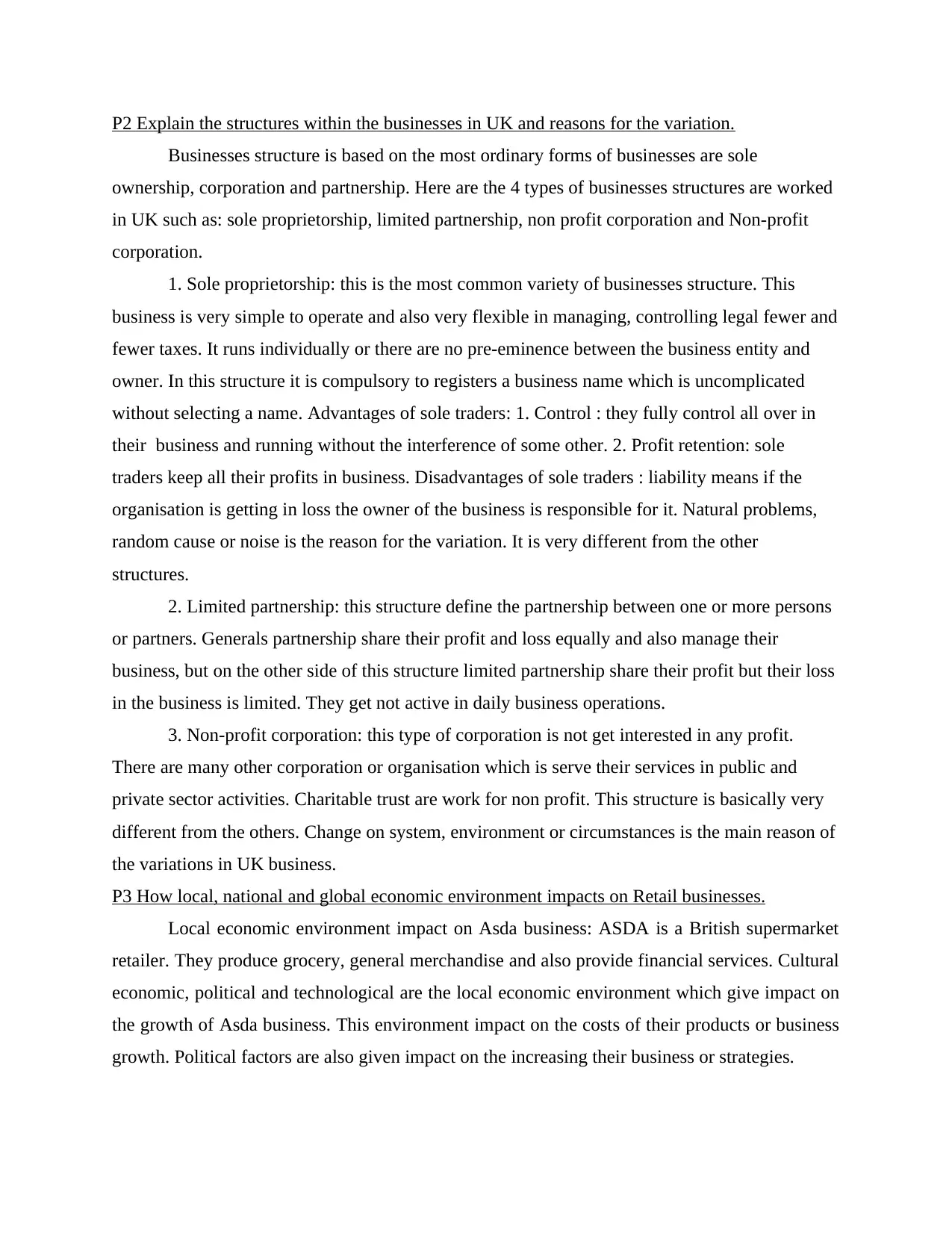
P2 Explain the structures within the businesses in UK and reasons for the variation.
Businesses structure is based on the most ordinary forms of businesses are sole
ownership, corporation and partnership. Here are the 4 types of businesses structures are worked
in UK such as: sole proprietorship, limited partnership, non profit corporation and Non-profit
corporation.
1. Sole proprietorship: this is the most common variety of businesses structure. This
business is very simple to operate and also very flexible in managing, controlling legal fewer and
fewer taxes. It runs individually or there are no pre-eminence between the business entity and
owner. In this structure it is compulsory to registers a business name which is uncomplicated
without selecting a name. Advantages of sole traders: 1. Control : they fully control all over in
their business and running without the interference of some other. 2. Profit retention: sole
traders keep all their profits in business. Disadvantages of sole traders : liability means if the
organisation is getting in loss the owner of the business is responsible for it. Natural problems,
random cause or noise is the reason for the variation. It is very different from the other
structures.
2. Limited partnership: this structure define the partnership between one or more persons
or partners. Generals partnership share their profit and loss equally and also manage their
business, but on the other side of this structure limited partnership share their profit but their loss
in the business is limited. They get not active in daily business operations.
3. Non-profit corporation: this type of corporation is not get interested in any profit.
There are many other corporation or organisation which is serve their services in public and
private sector activities. Charitable trust are work for non profit. This structure is basically very
different from the others. Change on system, environment or circumstances is the main reason of
the variations in UK business.
P3 How local, national and global economic environment impacts on Retail businesses.
Local economic environment impact on Asda business: ASDA is a British supermarket
retailer. They produce grocery, general merchandise and also provide financial services. Cultural
economic, political and technological are the local economic environment which give impact on
the growth of Asda business. This environment impact on the costs of their products or business
growth. Political factors are also given impact on the increasing their business or strategies.
Businesses structure is based on the most ordinary forms of businesses are sole
ownership, corporation and partnership. Here are the 4 types of businesses structures are worked
in UK such as: sole proprietorship, limited partnership, non profit corporation and Non-profit
corporation.
1. Sole proprietorship: this is the most common variety of businesses structure. This
business is very simple to operate and also very flexible in managing, controlling legal fewer and
fewer taxes. It runs individually or there are no pre-eminence between the business entity and
owner. In this structure it is compulsory to registers a business name which is uncomplicated
without selecting a name. Advantages of sole traders: 1. Control : they fully control all over in
their business and running without the interference of some other. 2. Profit retention: sole
traders keep all their profits in business. Disadvantages of sole traders : liability means if the
organisation is getting in loss the owner of the business is responsible for it. Natural problems,
random cause or noise is the reason for the variation. It is very different from the other
structures.
2. Limited partnership: this structure define the partnership between one or more persons
or partners. Generals partnership share their profit and loss equally and also manage their
business, but on the other side of this structure limited partnership share their profit but their loss
in the business is limited. They get not active in daily business operations.
3. Non-profit corporation: this type of corporation is not get interested in any profit.
There are many other corporation or organisation which is serve their services in public and
private sector activities. Charitable trust are work for non profit. This structure is basically very
different from the others. Change on system, environment or circumstances is the main reason of
the variations in UK business.
P3 How local, national and global economic environment impacts on Retail businesses.
Local economic environment impact on Asda business: ASDA is a British supermarket
retailer. They produce grocery, general merchandise and also provide financial services. Cultural
economic, political and technological are the local economic environment which give impact on
the growth of Asda business. This environment impact on the costs of their products or business
growth. Political factors are also given impact on the increasing their business or strategies.
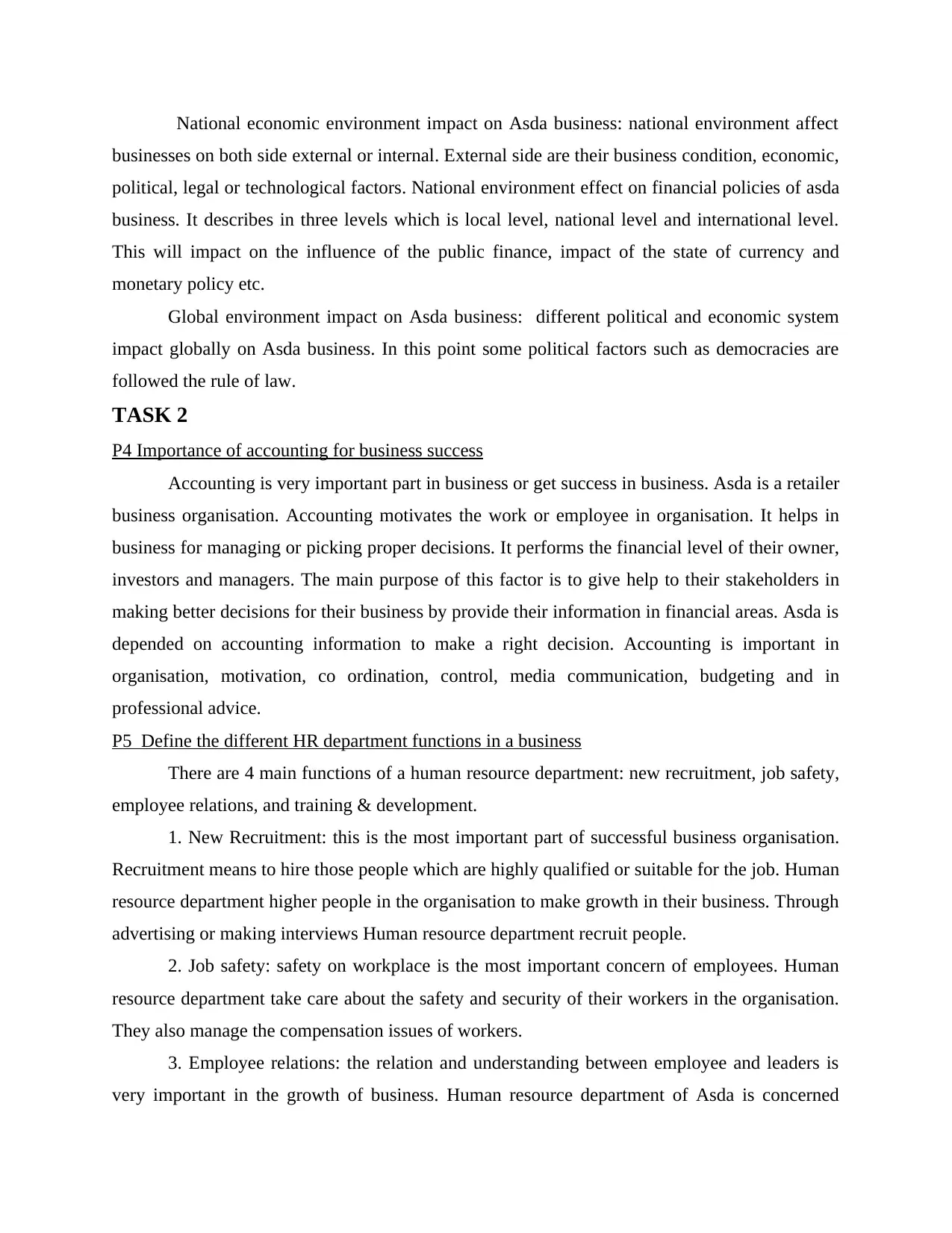
National economic environment impact on Asda business: national environment affect
businesses on both side external or internal. External side are their business condition, economic,
political, legal or technological factors. National environment effect on financial policies of asda
business. It describes in three levels which is local level, national level and international level.
This will impact on the influence of the public finance, impact of the state of currency and
monetary policy etc.
Global environment impact on Asda business: different political and economic system
impact globally on Asda business. In this point some political factors such as democracies are
followed the rule of law.
TASK 2
P4 Importance of accounting for business success
Accounting is very important part in business or get success in business. Asda is a retailer
business organisation. Accounting motivates the work or employee in organisation. It helps in
business for managing or picking proper decisions. It performs the financial level of their owner,
investors and managers. The main purpose of this factor is to give help to their stakeholders in
making better decisions for their business by provide their information in financial areas. Asda is
depended on accounting information to make a right decision. Accounting is important in
organisation, motivation, co ordination, control, media communication, budgeting and in
professional advice.
P5 Define the different HR department functions in a business
There are 4 main functions of a human resource department: new recruitment, job safety,
employee relations, and training & development.
1. New Recruitment: this is the most important part of successful business organisation.
Recruitment means to hire those people which are highly qualified or suitable for the job. Human
resource department higher people in the organisation to make growth in their business. Through
advertising or making interviews Human resource department recruit people.
2. Job safety: safety on workplace is the most important concern of employees. Human
resource department take care about the safety and security of their workers in the organisation.
They also manage the compensation issues of workers.
3. Employee relations: the relation and understanding between employee and leaders is
very important in the growth of business. Human resource department of Asda is concerned
businesses on both side external or internal. External side are their business condition, economic,
political, legal or technological factors. National environment effect on financial policies of asda
business. It describes in three levels which is local level, national level and international level.
This will impact on the influence of the public finance, impact of the state of currency and
monetary policy etc.
Global environment impact on Asda business: different political and economic system
impact globally on Asda business. In this point some political factors such as democracies are
followed the rule of law.
TASK 2
P4 Importance of accounting for business success
Accounting is very important part in business or get success in business. Asda is a retailer
business organisation. Accounting motivates the work or employee in organisation. It helps in
business for managing or picking proper decisions. It performs the financial level of their owner,
investors and managers. The main purpose of this factor is to give help to their stakeholders in
making better decisions for their business by provide their information in financial areas. Asda is
depended on accounting information to make a right decision. Accounting is important in
organisation, motivation, co ordination, control, media communication, budgeting and in
professional advice.
P5 Define the different HR department functions in a business
There are 4 main functions of a human resource department: new recruitment, job safety,
employee relations, and training & development.
1. New Recruitment: this is the most important part of successful business organisation.
Recruitment means to hire those people which are highly qualified or suitable for the job. Human
resource department higher people in the organisation to make growth in their business. Through
advertising or making interviews Human resource department recruit people.
2. Job safety: safety on workplace is the most important concern of employees. Human
resource department take care about the safety and security of their workers in the organisation.
They also manage the compensation issues of workers.
3. Employee relations: the relation and understanding between employee and leaders is
very important in the growth of business. Human resource department of Asda is concerned
⊘ This is a preview!⊘
Do you want full access?
Subscribe today to unlock all pages.

Trusted by 1+ million students worldwide
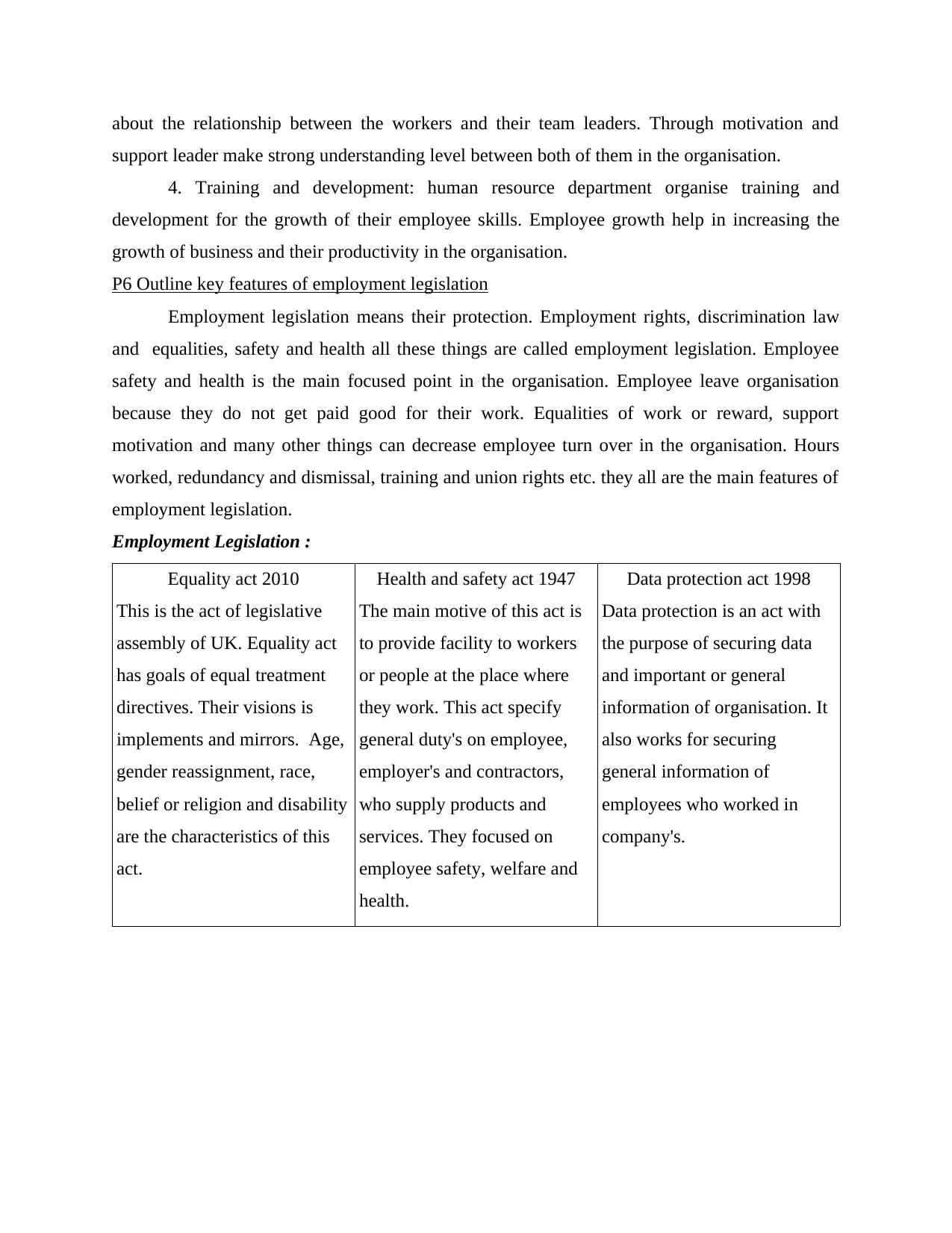
about the relationship between the workers and their team leaders. Through motivation and
support leader make strong understanding level between both of them in the organisation.
4. Training and development: human resource department organise training and
development for the growth of their employee skills. Employee growth help in increasing the
growth of business and their productivity in the organisation.
P6 Outline key features of employment legislation
Employment legislation means their protection. Employment rights, discrimination law
and equalities, safety and health all these things are called employment legislation. Employee
safety and health is the main focused point in the organisation. Employee leave organisation
because they do not get paid good for their work. Equalities of work or reward, support
motivation and many other things can decrease employee turn over in the organisation. Hours
worked, redundancy and dismissal, training and union rights etc. they all are the main features of
employment legislation.
Employment Legislation :
Equality act 2010
This is the act of legislative
assembly of UK. Equality act
has goals of equal treatment
directives. Their visions is
implements and mirrors. Age,
gender reassignment, race,
belief or religion and disability
are the characteristics of this
act.
Health and safety act 1947
The main motive of this act is
to provide facility to workers
or people at the place where
they work. This act specify
general duty's on employee,
employer's and contractors,
who supply products and
services. They focused on
employee safety, welfare and
health.
Data protection act 1998
Data protection is an act with
the purpose of securing data
and important or general
information of organisation. It
also works for securing
general information of
employees who worked in
company's.
support leader make strong understanding level between both of them in the organisation.
4. Training and development: human resource department organise training and
development for the growth of their employee skills. Employee growth help in increasing the
growth of business and their productivity in the organisation.
P6 Outline key features of employment legislation
Employment legislation means their protection. Employment rights, discrimination law
and equalities, safety and health all these things are called employment legislation. Employee
safety and health is the main focused point in the organisation. Employee leave organisation
because they do not get paid good for their work. Equalities of work or reward, support
motivation and many other things can decrease employee turn over in the organisation. Hours
worked, redundancy and dismissal, training and union rights etc. they all are the main features of
employment legislation.
Employment Legislation :
Equality act 2010
This is the act of legislative
assembly of UK. Equality act
has goals of equal treatment
directives. Their visions is
implements and mirrors. Age,
gender reassignment, race,
belief or religion and disability
are the characteristics of this
act.
Health and safety act 1947
The main motive of this act is
to provide facility to workers
or people at the place where
they work. This act specify
general duty's on employee,
employer's and contractors,
who supply products and
services. They focused on
employee safety, welfare and
health.
Data protection act 1998
Data protection is an act with
the purpose of securing data
and important or general
information of organisation. It
also works for securing
general information of
employees who worked in
company's.
Paraphrase This Document
Need a fresh take? Get an instant paraphrase of this document with our AI Paraphraser
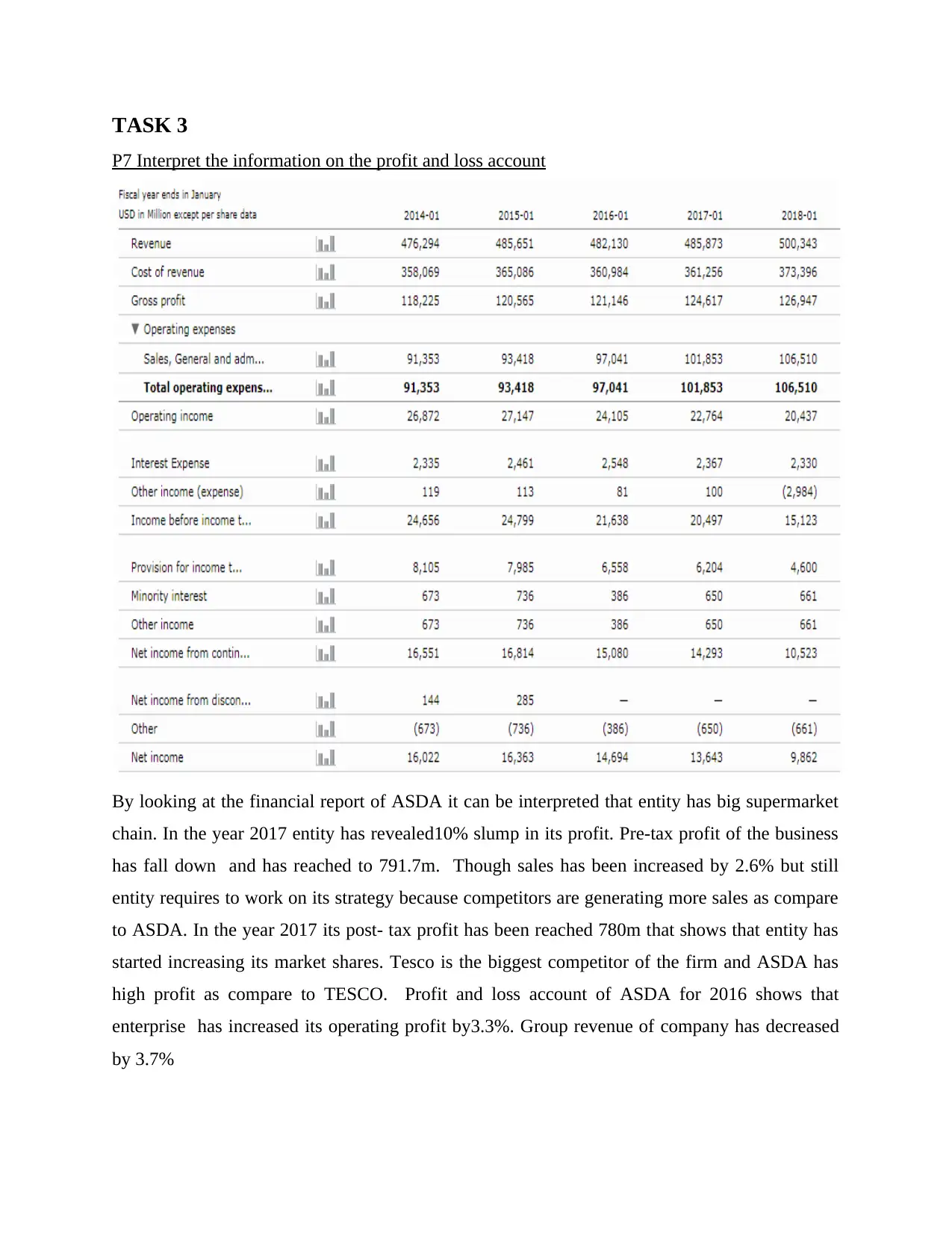
TASK 3
P7 Interpret the information on the profit and loss account
By looking at the financial report of ASDA it can be interpreted that entity has big supermarket
chain. In the year 2017 entity has revealed10% slump in its profit. Pre-tax profit of the business
has fall down and has reached to 791.7m. Though sales has been increased by 2.6% but still
entity requires to work on its strategy because competitors are generating more sales as compare
to ASDA. In the year 2017 its post- tax profit has been reached 780m that shows that entity has
started increasing its market shares. Tesco is the biggest competitor of the firm and ASDA has
high profit as compare to TESCO. Profit and loss account of ASDA for 2016 shows that
enterprise has increased its operating profit by3.3%. Group revenue of company has decreased
by 3.7%
P7 Interpret the information on the profit and loss account
By looking at the financial report of ASDA it can be interpreted that entity has big supermarket
chain. In the year 2017 entity has revealed10% slump in its profit. Pre-tax profit of the business
has fall down and has reached to 791.7m. Though sales has been increased by 2.6% but still
entity requires to work on its strategy because competitors are generating more sales as compare
to ASDA. In the year 2017 its post- tax profit has been reached 780m that shows that entity has
started increasing its market shares. Tesco is the biggest competitor of the firm and ASDA has
high profit as compare to TESCO. Profit and loss account of ASDA for 2016 shows that
enterprise has increased its operating profit by3.3%. Group revenue of company has decreased
by 3.7%
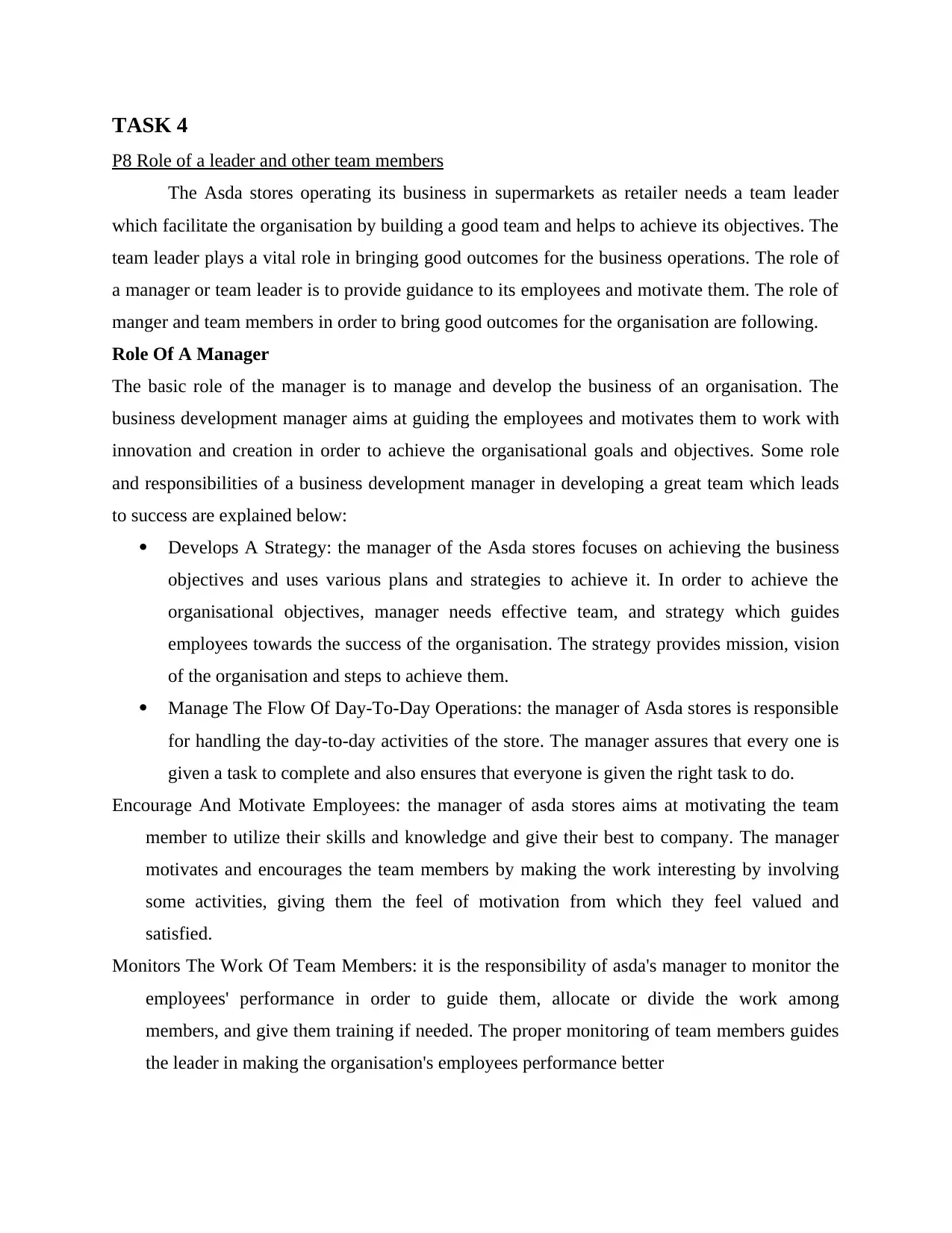
TASK 4
P8 Role of a leader and other team members
The Asda stores operating its business in supermarkets as retailer needs a team leader
which facilitate the organisation by building a good team and helps to achieve its objectives. The
team leader plays a vital role in bringing good outcomes for the business operations. The role of
a manager or team leader is to provide guidance to its employees and motivate them. The role of
manger and team members in order to bring good outcomes for the organisation are following.
Role Of A Manager
The basic role of the manager is to manage and develop the business of an organisation. The
business development manager aims at guiding the employees and motivates them to work with
innovation and creation in order to achieve the organisational goals and objectives. Some role
and responsibilities of a business development manager in developing a great team which leads
to success are explained below:
Develops A Strategy: the manager of the Asda stores focuses on achieving the business
objectives and uses various plans and strategies to achieve it. In order to achieve the
organisational objectives, manager needs effective team, and strategy which guides
employees towards the success of the organisation. The strategy provides mission, vision
of the organisation and steps to achieve them.
Manage The Flow Of Day-To-Day Operations: the manager of Asda stores is responsible
for handling the day-to-day activities of the store. The manager assures that every one is
given a task to complete and also ensures that everyone is given the right task to do.
Encourage And Motivate Employees: the manager of asda stores aims at motivating the team
member to utilize their skills and knowledge and give their best to company. The manager
motivates and encourages the team members by making the work interesting by involving
some activities, giving them the feel of motivation from which they feel valued and
satisfied.
Monitors The Work Of Team Members: it is the responsibility of asda's manager to monitor the
employees' performance in order to guide them, allocate or divide the work among
members, and give them training if needed. The proper monitoring of team members guides
the leader in making the organisation's employees performance better
P8 Role of a leader and other team members
The Asda stores operating its business in supermarkets as retailer needs a team leader
which facilitate the organisation by building a good team and helps to achieve its objectives. The
team leader plays a vital role in bringing good outcomes for the business operations. The role of
a manager or team leader is to provide guidance to its employees and motivate them. The role of
manger and team members in order to bring good outcomes for the organisation are following.
Role Of A Manager
The basic role of the manager is to manage and develop the business of an organisation. The
business development manager aims at guiding the employees and motivates them to work with
innovation and creation in order to achieve the organisational goals and objectives. Some role
and responsibilities of a business development manager in developing a great team which leads
to success are explained below:
Develops A Strategy: the manager of the Asda stores focuses on achieving the business
objectives and uses various plans and strategies to achieve it. In order to achieve the
organisational objectives, manager needs effective team, and strategy which guides
employees towards the success of the organisation. The strategy provides mission, vision
of the organisation and steps to achieve them.
Manage The Flow Of Day-To-Day Operations: the manager of Asda stores is responsible
for handling the day-to-day activities of the store. The manager assures that every one is
given a task to complete and also ensures that everyone is given the right task to do.
Encourage And Motivate Employees: the manager of asda stores aims at motivating the team
member to utilize their skills and knowledge and give their best to company. The manager
motivates and encourages the team members by making the work interesting by involving
some activities, giving them the feel of motivation from which they feel valued and
satisfied.
Monitors The Work Of Team Members: it is the responsibility of asda's manager to monitor the
employees' performance in order to guide them, allocate or divide the work among
members, and give them training if needed. The proper monitoring of team members guides
the leader in making the organisation's employees performance better
⊘ This is a preview!⊘
Do you want full access?
Subscribe today to unlock all pages.

Trusted by 1+ million students worldwide
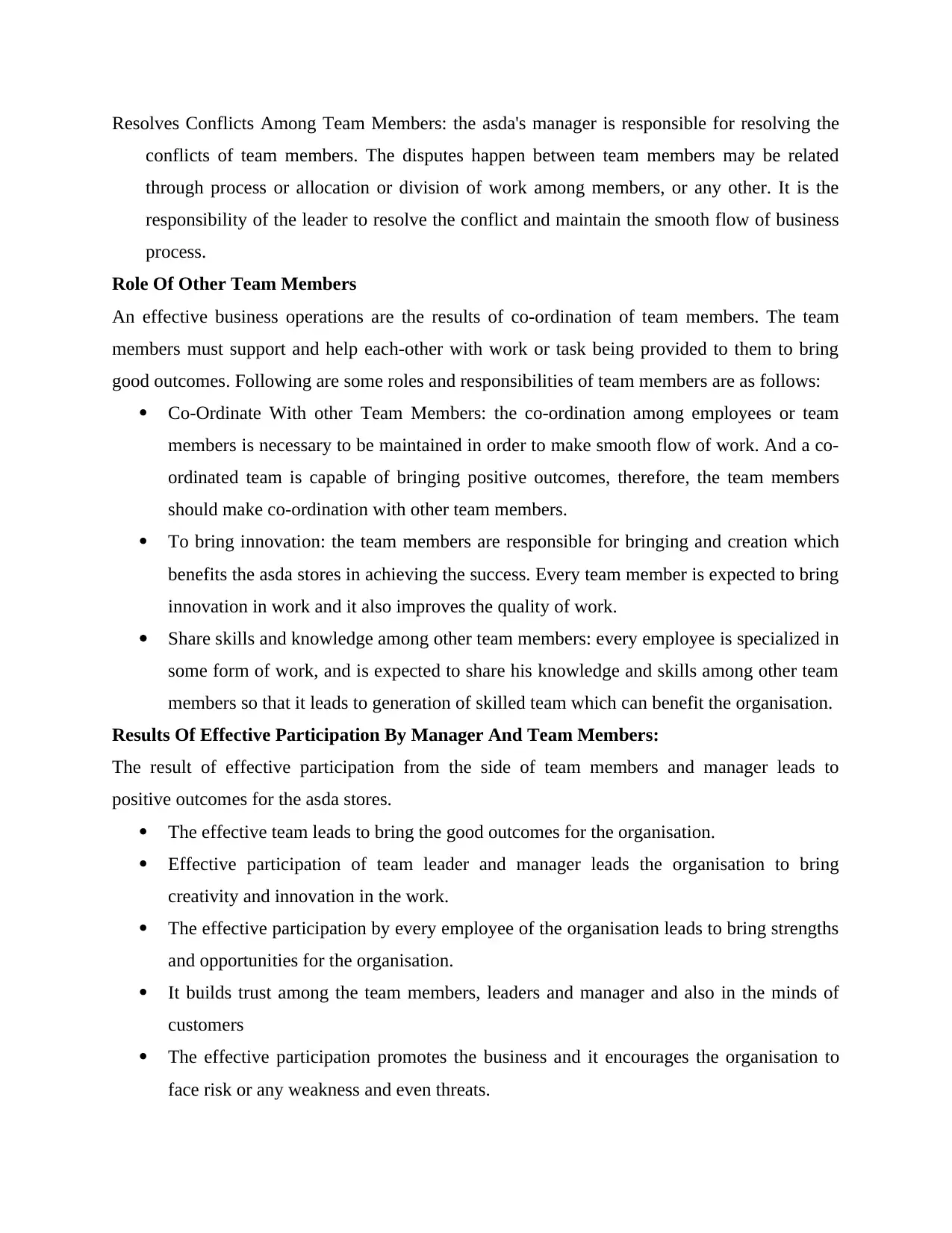
Resolves Conflicts Among Team Members: the asda's manager is responsible for resolving the
conflicts of team members. The disputes happen between team members may be related
through process or allocation or division of work among members, or any other. It is the
responsibility of the leader to resolve the conflict and maintain the smooth flow of business
process.
Role Of Other Team Members
An effective business operations are the results of co-ordination of team members. The team
members must support and help each-other with work or task being provided to them to bring
good outcomes. Following are some roles and responsibilities of team members are as follows:
Co-Ordinate With other Team Members: the co-ordination among employees or team
members is necessary to be maintained in order to make smooth flow of work. And a co-
ordinated team is capable of bringing positive outcomes, therefore, the team members
should make co-ordination with other team members.
To bring innovation: the team members are responsible for bringing and creation which
benefits the asda stores in achieving the success. Every team member is expected to bring
innovation in work and it also improves the quality of work.
Share skills and knowledge among other team members: every employee is specialized in
some form of work, and is expected to share his knowledge and skills among other team
members so that it leads to generation of skilled team which can benefit the organisation.
Results Of Effective Participation By Manager And Team Members:
The result of effective participation from the side of team members and manager leads to
positive outcomes for the asda stores.
The effective team leads to bring the good outcomes for the organisation.
Effective participation of team leader and manager leads the organisation to bring
creativity and innovation in the work.
The effective participation by every employee of the organisation leads to bring strengths
and opportunities for the organisation.
It builds trust among the team members, leaders and manager and also in the minds of
customers
The effective participation promotes the business and it encourages the organisation to
face risk or any weakness and even threats.
conflicts of team members. The disputes happen between team members may be related
through process or allocation or division of work among members, or any other. It is the
responsibility of the leader to resolve the conflict and maintain the smooth flow of business
process.
Role Of Other Team Members
An effective business operations are the results of co-ordination of team members. The team
members must support and help each-other with work or task being provided to them to bring
good outcomes. Following are some roles and responsibilities of team members are as follows:
Co-Ordinate With other Team Members: the co-ordination among employees or team
members is necessary to be maintained in order to make smooth flow of work. And a co-
ordinated team is capable of bringing positive outcomes, therefore, the team members
should make co-ordination with other team members.
To bring innovation: the team members are responsible for bringing and creation which
benefits the asda stores in achieving the success. Every team member is expected to bring
innovation in work and it also improves the quality of work.
Share skills and knowledge among other team members: every employee is specialized in
some form of work, and is expected to share his knowledge and skills among other team
members so that it leads to generation of skilled team which can benefit the organisation.
Results Of Effective Participation By Manager And Team Members:
The result of effective participation from the side of team members and manager leads to
positive outcomes for the asda stores.
The effective team leads to bring the good outcomes for the organisation.
Effective participation of team leader and manager leads the organisation to bring
creativity and innovation in the work.
The effective participation by every employee of the organisation leads to bring strengths
and opportunities for the organisation.
It builds trust among the team members, leaders and manager and also in the minds of
customers
The effective participation promotes the business and it encourages the organisation to
face risk or any weakness and even threats.
Paraphrase This Document
Need a fresh take? Get an instant paraphrase of this document with our AI Paraphraser
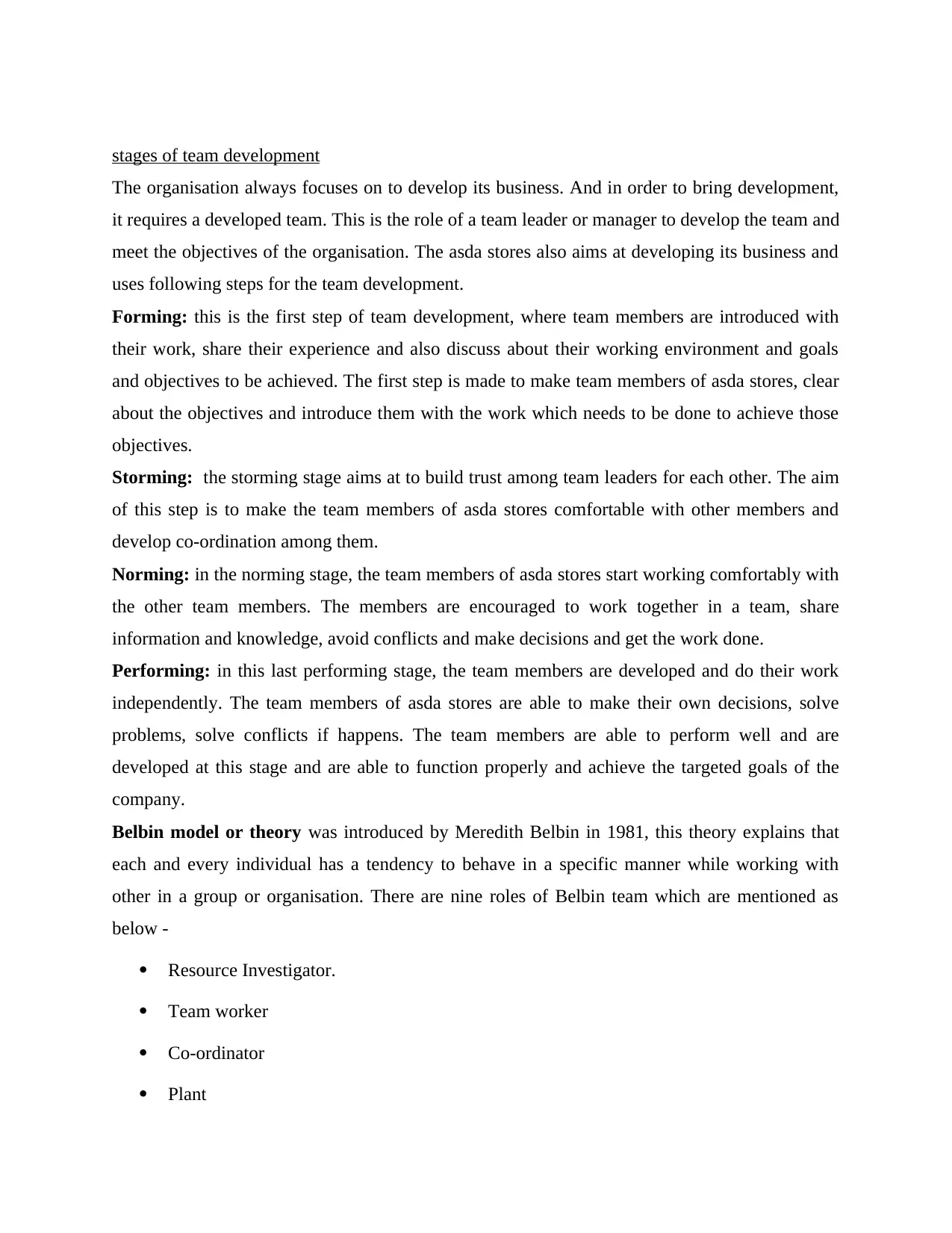
stages of team development
The organisation always focuses on to develop its business. And in order to bring development,
it requires a developed team. This is the role of a team leader or manager to develop the team and
meet the objectives of the organisation. The asda stores also aims at developing its business and
uses following steps for the team development.
Forming: this is the first step of team development, where team members are introduced with
their work, share their experience and also discuss about their working environment and goals
and objectives to be achieved. The first step is made to make team members of asda stores, clear
about the objectives and introduce them with the work which needs to be done to achieve those
objectives.
Storming: the storming stage aims at to build trust among team leaders for each other. The aim
of this step is to make the team members of asda stores comfortable with other members and
develop co-ordination among them.
Norming: in the norming stage, the team members of asda stores start working comfortably with
the other team members. The members are encouraged to work together in a team, share
information and knowledge, avoid conflicts and make decisions and get the work done.
Performing: in this last performing stage, the team members are developed and do their work
independently. The team members of asda stores are able to make their own decisions, solve
problems, solve conflicts if happens. The team members are able to perform well and are
developed at this stage and are able to function properly and achieve the targeted goals of the
company.
Belbin model or theory was introduced by Meredith Belbin in 1981, this theory explains that
each and every individual has a tendency to behave in a specific manner while working with
other in a group or organisation. There are nine roles of Belbin team which are mentioned as
below -
Resource Investigator.
Team worker
Co-ordinator
Plant
The organisation always focuses on to develop its business. And in order to bring development,
it requires a developed team. This is the role of a team leader or manager to develop the team and
meet the objectives of the organisation. The asda stores also aims at developing its business and
uses following steps for the team development.
Forming: this is the first step of team development, where team members are introduced with
their work, share their experience and also discuss about their working environment and goals
and objectives to be achieved. The first step is made to make team members of asda stores, clear
about the objectives and introduce them with the work which needs to be done to achieve those
objectives.
Storming: the storming stage aims at to build trust among team leaders for each other. The aim
of this step is to make the team members of asda stores comfortable with other members and
develop co-ordination among them.
Norming: in the norming stage, the team members of asda stores start working comfortably with
the other team members. The members are encouraged to work together in a team, share
information and knowledge, avoid conflicts and make decisions and get the work done.
Performing: in this last performing stage, the team members are developed and do their work
independently. The team members of asda stores are able to make their own decisions, solve
problems, solve conflicts if happens. The team members are able to perform well and are
developed at this stage and are able to function properly and achieve the targeted goals of the
company.
Belbin model or theory was introduced by Meredith Belbin in 1981, this theory explains that
each and every individual has a tendency to behave in a specific manner while working with
other in a group or organisation. There are nine roles of Belbin team which are mentioned as
below -
Resource Investigator.
Team worker
Co-ordinator
Plant
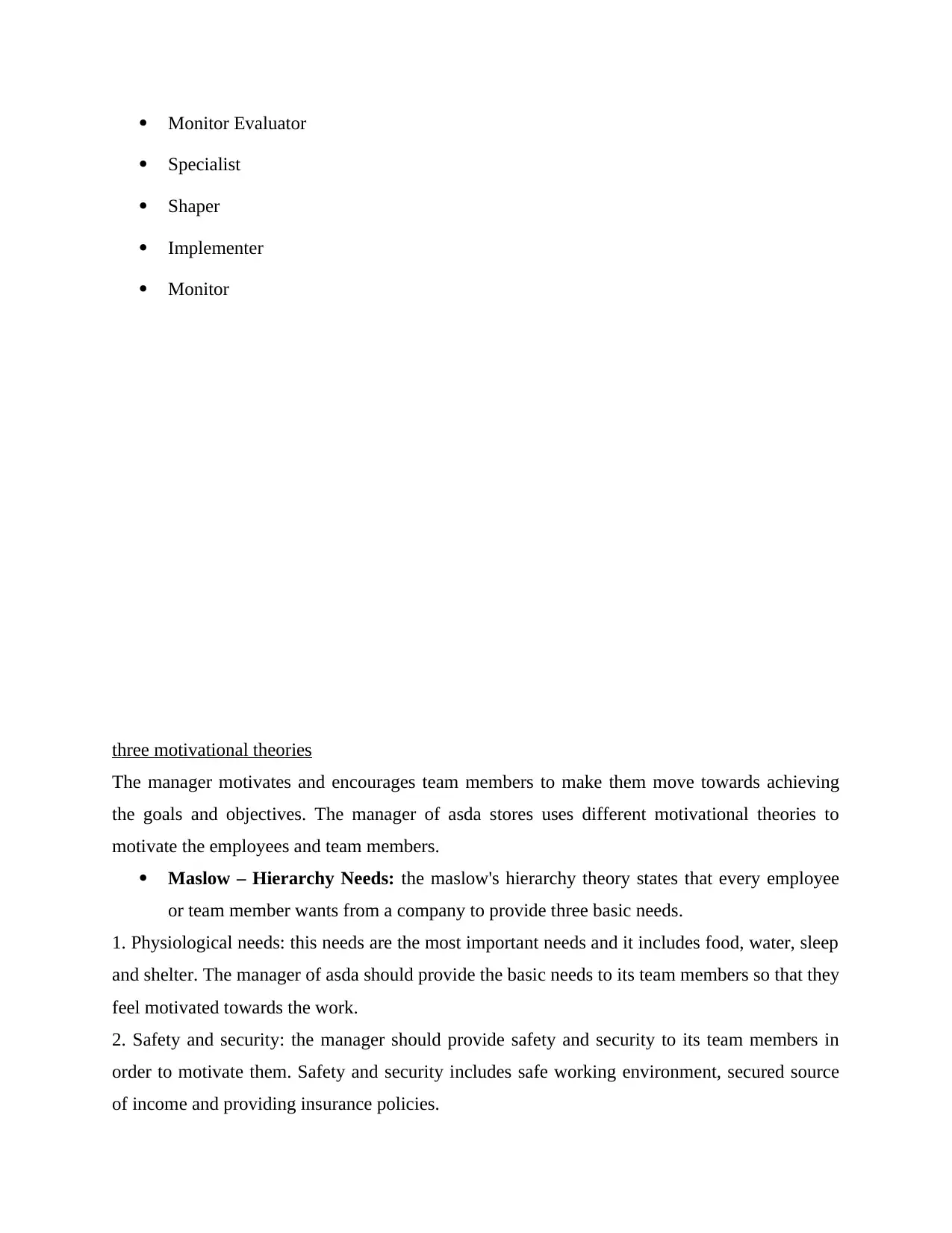
Monitor Evaluator
Specialist
Shaper
Implementer
Monitor
three motivational theories
The manager motivates and encourages team members to make them move towards achieving
the goals and objectives. The manager of asda stores uses different motivational theories to
motivate the employees and team members.
Maslow – Hierarchy Needs: the maslow's hierarchy theory states that every employee
or team member wants from a company to provide three basic needs.
1. Physiological needs: this needs are the most important needs and it includes food, water, sleep
and shelter. The manager of asda should provide the basic needs to its team members so that they
feel motivated towards the work.
2. Safety and security: the manager should provide safety and security to its team members in
order to motivate them. Safety and security includes safe working environment, secured source
of income and providing insurance policies.
Specialist
Shaper
Implementer
Monitor
three motivational theories
The manager motivates and encourages team members to make them move towards achieving
the goals and objectives. The manager of asda stores uses different motivational theories to
motivate the employees and team members.
Maslow – Hierarchy Needs: the maslow's hierarchy theory states that every employee
or team member wants from a company to provide three basic needs.
1. Physiological needs: this needs are the most important needs and it includes food, water, sleep
and shelter. The manager of asda should provide the basic needs to its team members so that they
feel motivated towards the work.
2. Safety and security: the manager should provide safety and security to its team members in
order to motivate them. Safety and security includes safe working environment, secured source
of income and providing insurance policies.
⊘ This is a preview!⊘
Do you want full access?
Subscribe today to unlock all pages.

Trusted by 1+ million students worldwide
1 out of 17
Related Documents
Your All-in-One AI-Powered Toolkit for Academic Success.
+13062052269
info@desklib.com
Available 24*7 on WhatsApp / Email
![[object Object]](/_next/static/media/star-bottom.7253800d.svg)
Unlock your academic potential
Copyright © 2020–2025 A2Z Services. All Rights Reserved. Developed and managed by ZUCOL.





